Using product-focused strategies to market a service business won’t necessarily deliver the results you’re after. Instead, use service-specific marketing strategies to attract new customers and keep your current ones coming back for more.
As the global economy shifts from products to services, starting a new service business — or growing your existing one — has never been a surer bet.
But product marketing strategies won’t pack the punch you need when advertising your service. Whether you’re promoting a local restaurant or law firm or building an online web design empire, your customers know they can’t return your service after paying for it, so you’ll need to work harder than product marketers in order to gain customers’ trust.
The good news is that dedicated service marketing strategies can help you create a customer experience that’ll impress new clients and keep your existing ones coming back for more.
Key Insights
- Clarifying your service process and unique value builds trust and differentiates your brand.
- A strong website with testimonials, detailed service pages, referral programs, and FAQs helps attract and convert clients.
10 targeted strategies for marketing services
Here are 10 marketing strategies to consider including in your marketing plan. To give you a sense of these strategies in action, here are examples from two Webflow clients: Total Dog! Dog Training Solutions and yoga therapist Simchah Huizar.
1. Use your website to explain how the service works
A business website is central to service marketing. It builds an online presence, establishes credibility, and provides a platform to promote your offering. Most product websites are fairly straightforward: They show images of the product, explain how it works, and outline how it can improve your life. But the specifics of services can be more difficult to communicate, as customers don’t come out of them with a concrete object in their hands. Include a clear and complete description of your service on the website to map out the process for clients ahead of time, introducing them to how it works and what to expect during the process.
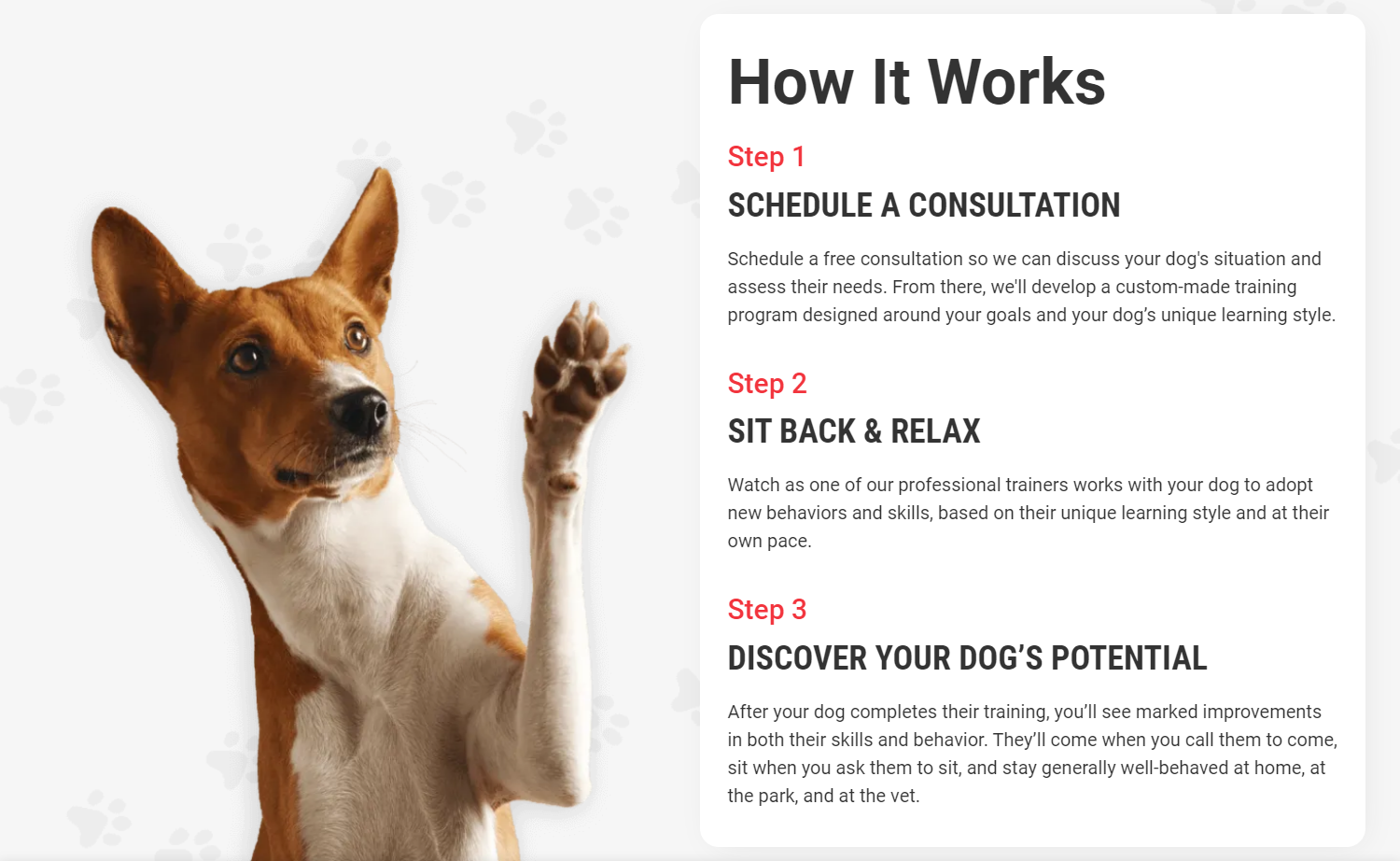
Total Dog! uses its website, designed by Geek Powered Studios, to dispel customer uncertainty and communicate a fun brand identity. The “How It Works” section of the site guides potential customers through the training process, clarifying what they’ll be paying for by listing the promised outcomes. The business also anticipates customer doubts in the FAQs section, smoothing the path toward that first consultation.
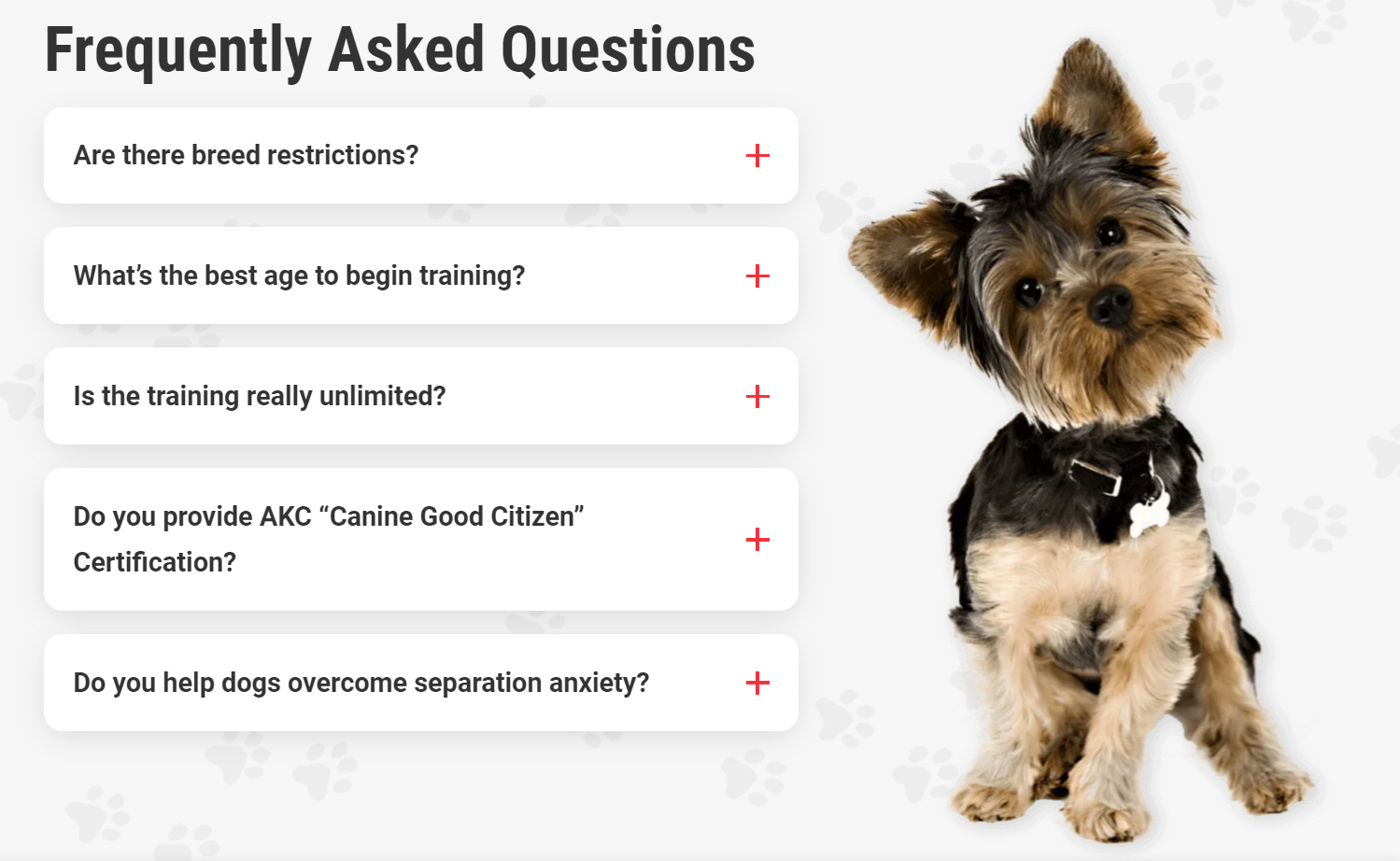
2. Determine (and communicate) your unique selling point
In marketing, the unique selling point (USP) is the value service or product provides for the customer. But the USP isn’t just about what’s being offered, it’s also about who’s offering it.
Unless your service involves minimal human contact (like a self-service car wash), it involves direct contact with clients, which is essential for building interpersonal relationships. Prospective customers understand the importance of these relationships, and will want to know who they’ll be working with before making a commitment.

Yoga therapist Simchah Huizar uses her website, designed by David Dickerson, to tell her story and express her distinctive approach to yoga — combining it with her Christian faith. Simchah’s site has photos of her in loose, comfortable clothing and simple yoga poses. These photos communicate her more casual, accessible approach.
3. Tailor your services
Product creators conduct market research to pinpoint their target audience, identify pain points, and refine the product according to the needs of that audience. But there's not much wiggle room to change the product once it’s ready to manufacture and distribute.
Most service-based businesses, on the other hand, can personalize what they offer. A good service marketing strategy highlights this flexibility by providing customers a range of options that suit different needs and budgets.
Simchah describes her Strength Under Pressure program as “a flexible yoga therapy option that gets to the root of your pain and stress and gives you a custom-crafted roadmap to healing,” assuring clients they’ll receive a service tailored to their individual needs. The emphasis on personalization differentiates Simchah from her competition and adds to her service’s USP.
4. Keep existing customers happy
Retaining existing customers is more cost-effective than attracting new ones. Across both products and services, it costs 5 to 25 times more to attract a new customer than to keep an existing one. This is especially true in service industries, where customer churn — the proportion of customers who stop using a service — can happen rapidly. Service clients have the freedom to shop around and switch to competitors, as they’re not tethered to a product they already have at home.This means service marketing efforts must prioritize maintaining and repairing existing customer relationships.
To keep your existing customers engaged, send regular (but not excessive) email marketing campaigns that offer clear value, such as previews of new features and appealing discount offers. Responding to customer inquiries and complaints promptly, asking for feedback, and implementing improvements to your service all show your customer base that you value their satisfaction.
5. Leverage social proof
Social proof is evidence that other people have gained value from a product or service. It includes word-of-mouth advertising, testimonials, customer reviews, and influencer marketing campaigns — and an effective marketing strategy uses a combination of these methods tailored to the target market. Social proof helps you build trust, which a valuable element of service marketing.
The easiest way to demonstrate social proof is to prominently feature testimonials and customer reviews on your website’s homepage or landing page.
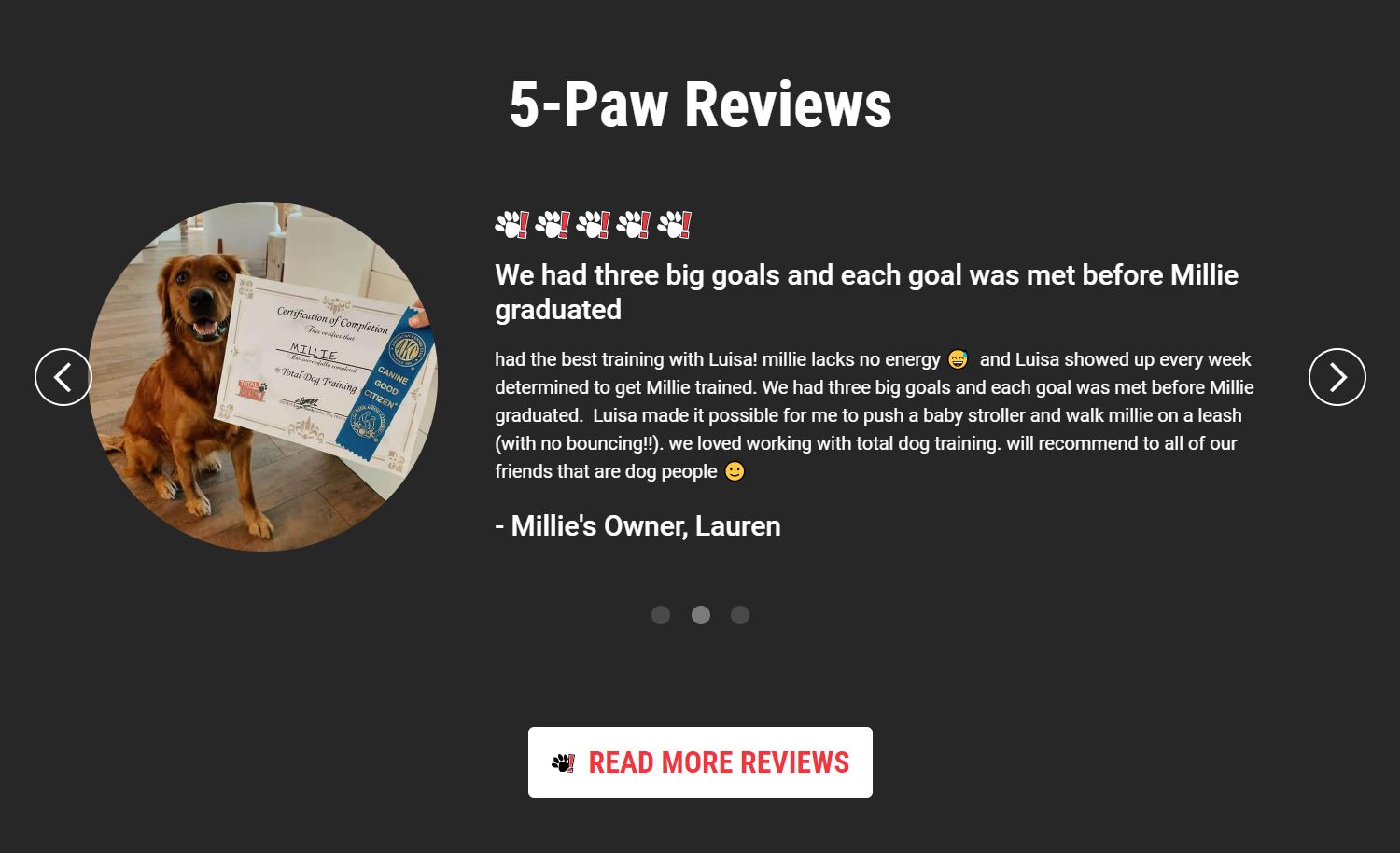
Total Dog! shows “5-paw reviews” from pet owners, including photos of the canine clients, creatively framing the testimonials with the company’s fun, “pun intended” brand personality by using paws rather than stars to rate customer satisfaction.


















6. Provide extraordinary customer service
To simultaneously tailor your services (#3), keep existing customers happy (#4), and strengthen social proof via positive reviews and word-of-mouth advertising (#5), offer outstanding customer service.
To benefit from word-of-mouth marketing and positive reviews, businesses must truly excel in the customer service department. To wow your clients, use the “service recovery paradox” — if a customer expresses dissatisfaction with the service, see this as an opportunity rather than a disaster. Handling the situation correctly helps ensure customers have a better opinion of the company — they know their concerns matter and their voices are heard.
7. Facilitate online bookings
Integrating an online scheduling app into your website to let clients book appointments and consultations has two advantages — it makes it easier for potential customers to take that first step and increases convenience for existing customers.
If your service requires a significant financial commitment up-front, consider offering a free introductory consultation to explain how your service helps prospective clients.
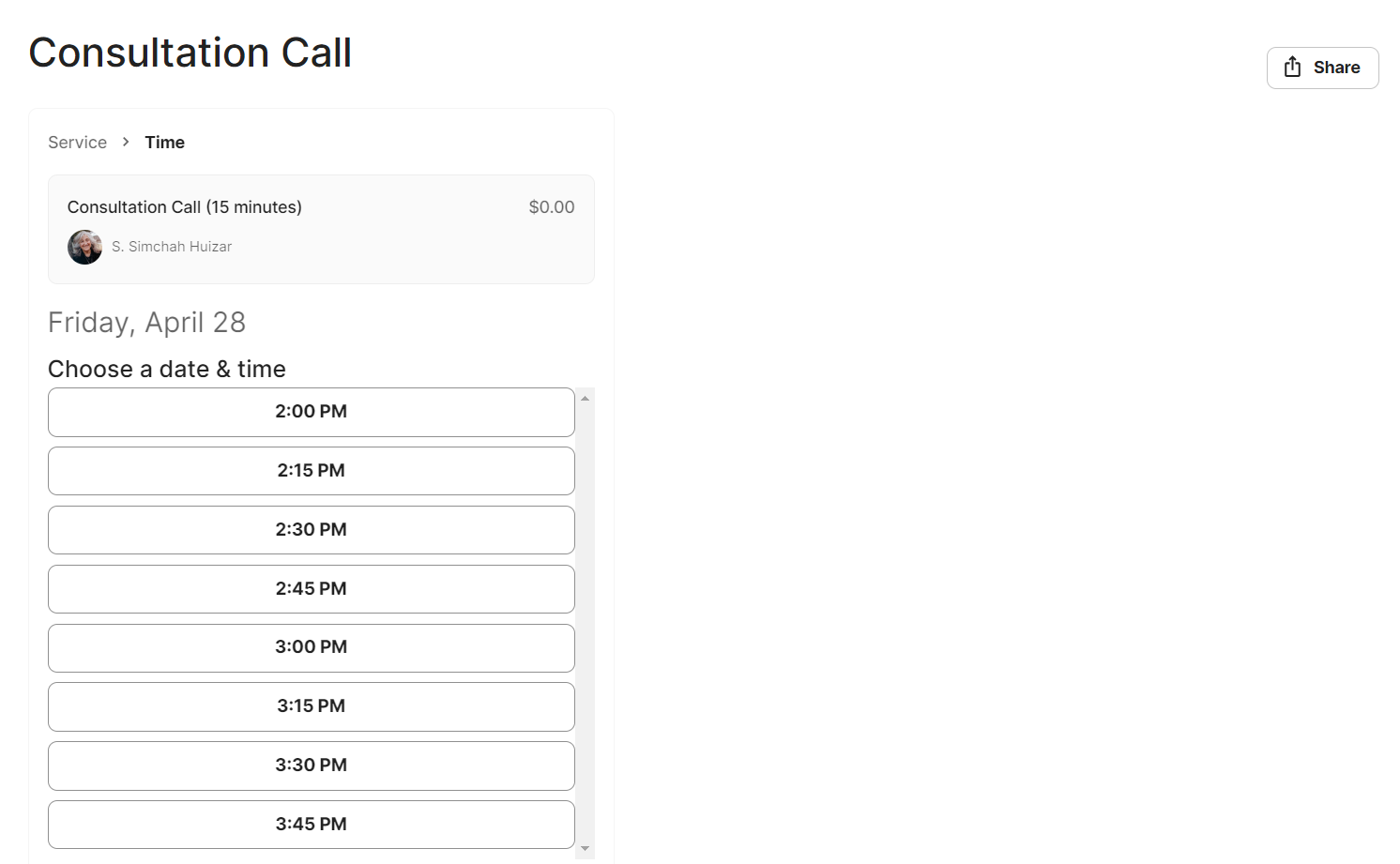
Simchah offers free 15-minute consultations for clients interested in working with her. Her online booking system makes it easy for prospective clients to schedule appointments, reducing the barriers to entry.
8. Create content strategically
Content creation is a core marketing strategy for both products and services. Blogging regularly, using social media platforms, offering valuable content, and posting videos keep your brand top of mind for customers. But understanding the distinct objectives of these strategies helps you accomplish your marketing goals faster. Let’s look at these marketing tactics one by one.
Blog regularly. Blogging builds client relationships. Use a blog to inform customers about new features of your service, promote time-sensitive deals, and show you’re keeping up with industry trends. Blogging is also an ideal search engine optimization (SEO) tool. Posting helpful, valuable content that contains the keywords people are searching for will help your site rank higher in search results, drawing more visitors to your website.
If you’re marketing a local business, SEO strategies tailored to a specific region such as posting geo-targeted content, registering your company for a Google Business profile, and including your address will help you rank higher in regional searches for your services.
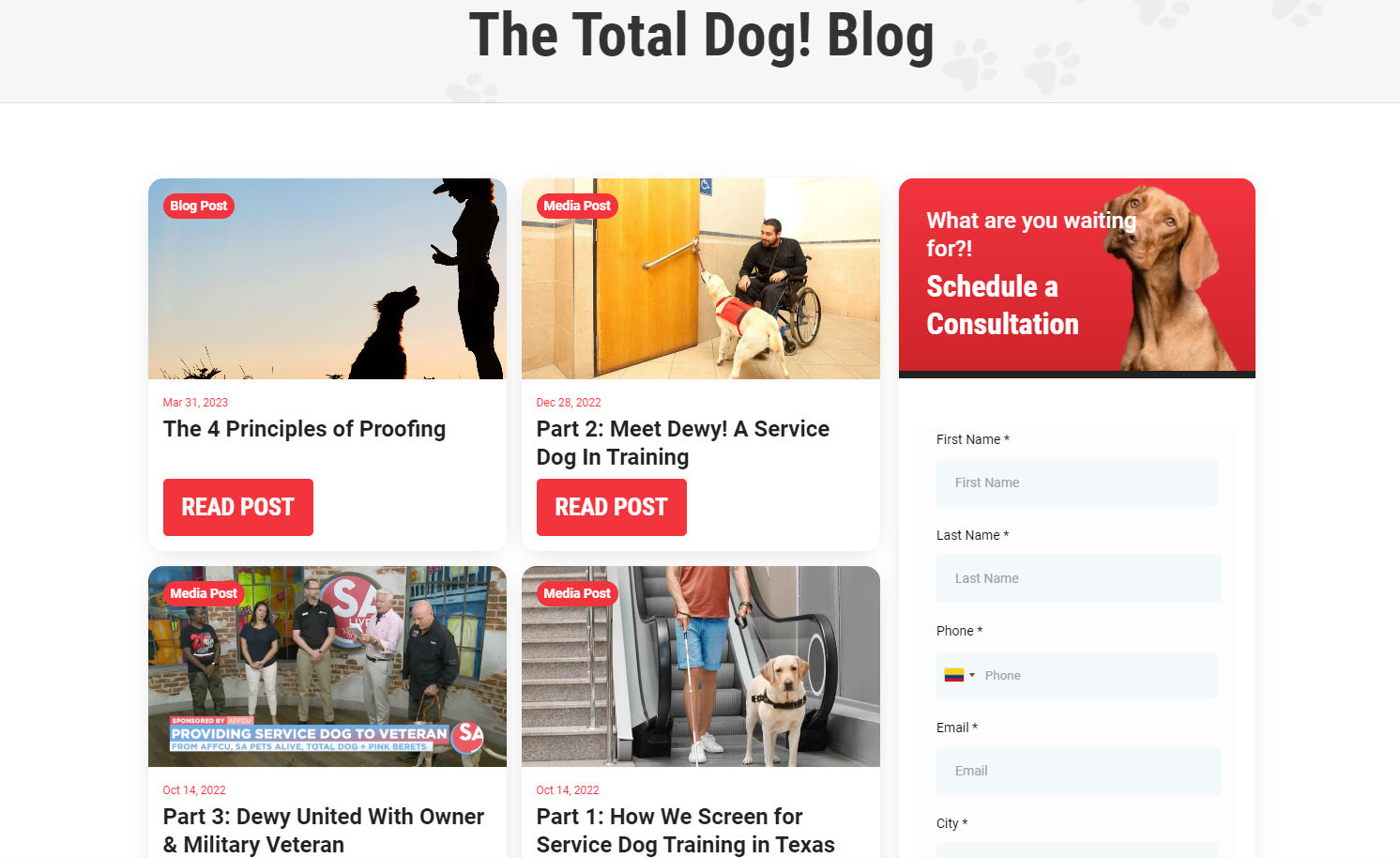
The Total Dog! blog includes valuable content for dog owners and Texas content ideal for local SEO.
Use social media. Engaging, entertaining social media posts help you build and maintain customer relationships. Paid social media marketing channels, such as pay-per-click (PPC) advertising on Facebook, can also have an excellent return on investment. If you’re interested in diversifying your digital marketing strategy but don’t have enough time to do it yourself, consider contracting a marketing agency to help.
Offer valuable content. Providing valuable content that helps searchers solve problems benefits you in several ways. You get to showcase your expertise, which builds trust and expose people to your brand, which builds brand recognition and awareness. Plus, you have the opportunity to directly market your services to those in need of your solutions.
Another strategy is to gate valuable content (make it available for download after users enter their email addresses), which helps you build an email list for future marketing campaigns.

Simchah offers a gated ebook that’s only available to people who sign up for her newsletter, building her email list by providing people with valuable content.
Post videos. In a recent survey by video production company Wyzowl, 89% of respondents said that watching a video had persuaded them to buy a product or service, and 96% had watched a video to learn more about a product or service. Even if you’re already producing video content, kick it up a notch — 91% of respondents wanted to see more video content from their favorite brands.
Video is particularly important for services as it can effectively explain and demonstrate the process. To share video content, post it on a YouTube channel, social media, or directly on your website.
9. Give welcome deals and referral perks
Offering welcome deals and free initial consultations is a great way to get new clients over the initial entry hump. Overcome reluctance and set the stage for a long-term relationship with discounted packs of appointments or consultations.
Also, consider extending rewards to existing customers who bring in new ones. Clients who have been referred to you are more loyal, bring in more profit, and stay with your brand for longer than those who haven’t, making referral marketing a smart strategy.
10. “Productize” your service
Delivering tailored services to hundreds of customers gives you insight into what the average customer wants and needs. Instead of treating each customer interaction as a one-off experience, consider leveraging that information to turn your service into a standardized product.
For example, a business consultant could release a self-paced course for entrepreneurs, while a web designer could create templates to sell rather than work directly with clients.
Productizing your service gives you a passive income stream that takes the pressure off individual service professionals. It also allows you to appeal to a broader audience and simultaneously offer the service to multiple people — which isn’t possible if your standard service only comes as a one-on-one consultation.

Simchah offers online video lessons and guided meditations for clients who want to work with her independently, which is a win-win strategy: The videos only cost a few dollars, so they’re cheaper for customers than working with Simchah individually, and the products continue to bring in revenue without costing Simchah any additional resources.
Remember to monitor the results
Let’s say you implement a few of the above strategies. How do you know which ones are getting you the best return on investment? Use these metrics to gauge effectiveness.
Click-through rate (CTR)
The CTR is the percentage of people who click on your content out of everyone who sees it. Organic (unpaid) CTRs come from search engine results, which you can check using a website analytics tool like Google Analytics. On Google Ads, a strong CTR is 6-7%, while on Facebook Ads a CTR of 2-5% is considered good. For email marketing campaigns, anything over 2.6% is above average. If your campaigns perform under these benchmarks, consider experimenting with other layouts and marketing messages.
Conversion rate
A conversion happens any time a user takes a desired action. If a visitor to the Total Dog! or Simchah Huizar website clicks on the “Book Free Consultation” button, that counts as a conversion. If you implement strategy #1 above (using your website to explain how your service works), monitoring your conversion rate will tell you whether the extra information encourages website visitors to take the action you’re aiming for.
Sales
Marketing tools track the sources of your sales, showing you the most effective marketing avenues. Tracking ecommerce site metrics such as member activation rate and average revenue per user also points to your marketing campaign's success — or failure.
Market your service business with Webflow
Choose a few of the marketing tips above and try them out, carefully monitoring the results.
If you’re starting a new business, implementing these strategies from the beginning should get your business off to a great start. And if you’re refining the marketing strategy of an existing service business, adjusting the content you already have along these lines should breathe new life into your marketing strategy.
No matter your business idea, Webflow can help you build an online presence that gives your marketing efforts a significant head start.

Build websites that get results.
Build visually, publish instantly, and scale safely and quickly — without writing a line of code. All with Webflow's website experience platform.































